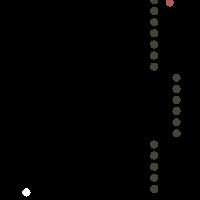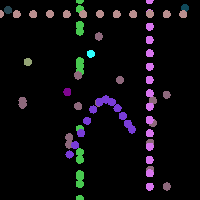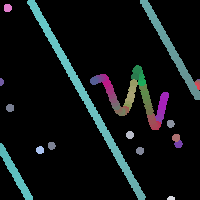Calvin Ashmore
Qualifying Exam 0
Question: Discuss the relationship between media technology and cultural change with reference to a selection of new media theorists (e.g. Jenkins, Negroponte, Rheingold, Bolter and Grusin, Brown & Duguid). Is digital technology bringing about changes in our culture? If so, what changes and how?
Understanding Culture
It is not uncommon to hear about how technology and in particular digital media are changing culture and society. We hear that digital technology has the capacity to revolutionize democracy, and in the same breath we might hear of the capacity for corporations to restrict our rights and liberties. Professions of the liberating powers of social computing tend to come right alongside the ominous warnings that technology will ultimately enslave us all. Looking back, it is possible to tell that the emerging prominence of digital technology has led to a culture with different capacities and values than before, but exactly how to understand that change is less clear.
The ready availability of information has led to changes in the values and practices that surround information. While cultural institutions, many of whose deaths wereheralded by the coming prominence of digital technology,remain, these institutions have nonetheless been changed by the technology available to them. Before we can understand how culture as a whole has been affected by digital technology, we must understand how to approach culture to be able to articulate what culture is. When we understand what culture is, then we can understand its capacity for change.
Articulating culture is not an easy thing. We all live in it, and we are thus intimately familiar with it, but when struck to articulate it, we tend to be at a loss. Much like media, culture is always simply there, and it is tricky to understand exactly our relation to it. Clifford Geertz struggled to find this out and did so by relating anthropology with semiotics, revolutionizing the discipline. To Geertz, culture is a web of significance [1]. The process of understanding culture requires a kind of interpretation. Even when one exists inside of a culture, the issue of the fundamental gap of human understanding is difficult to bear. Wittgenstein wrote that we can never truly understand one another, but this perspective leads to one of irrecoverable alienation. Geertz argues that, culture is public meaning and common interpretation of relevant symbols.
With this in mind, the matter of understanding cultural change is a semiotic issue. Understanding change requires understanding how the relation of symbols changes with respect to each other. Systems of meaning might adapt and incorporate new elements, or they might become replaced by other points of signification. If semiotic systems are the means of understanding interpreting cultures, then cultural creations must be considered the artifacts and logical products of those systems. The work of art has in the past tended to take on various cultural functions, usually relating to ritual and mythic systems. Technology has necessarily aided the power of a culture to produce artifacts, and as a result the functions of those artifacts has tended to change.
The role of art within this is to represent the authority of the cultural creation. Historically, works of art have tended to represent their cultural value system. In the middle ages in Europe, art represented the authority and centrality of the soverign, but as the merchant classes began to emerge and take on cultural legitimacy, they used art to reflect their own emerging legitimacy as well.
Media and Culture
The role of media within culture serves another story.
When technology reached the level of accurate reproduction, the authority and power of the original is confused. Walter Benjamin found that mechanical reproduction could be used to change the function of art from one of authoratization to a political popularization [2]. Benjamin was fascinated by the ability for art to recast cultural values in new ways. This insight was merely a harbinger of the values of postmodernism in recasting culture. Reproductions are generally considered artifacts for consumption, consumer goods, products. It is the role of these to be distributed and widely consumed, thus reincorporating the symbolic value of the artifacts into the culture at large.
Mechanical reproduction was indeed remarkable to so many because of the perceived ability of the copy to affect the original. While the original could not be physically molested by the proliferation of reproductions, its cultural position and legitimacy could certainly be called into question. The emergence of digital technology only complicates things further. With digital artifacts, themselves being defined as long sequences of numerical data, the idea of originality and authenticity are totally lost. This is one way in which culture has been affected by media technology. But this is just one step. Media technology is certainly not only about specific works and artifacts. Media itself has become an object of considerable significance. Beginning with Marshal McLuhan, the media has become a focal point in the understanding of culture. The impact of this is especially clear with the advent of television.
Turning our attention to media specifically, at least in the sense that we relate to media, we can see that it too is highly representative of our cultural situation. However, the capacity that cultural products have to influence culture itself is greatly amplified with media, in the sense that it may be ubiquitous and pervasive. Where art and traditional artifacts may tell us the “what” of our culture, media tells us “how”. When the radio became popular in America in the 30s and 40s, culture became oriented around it. In the sense that culture is a web of significance, radio seemed to connect to all points on that web, effectively becoming its center.
While technology can affect the types of media that emerge, it would be a mistake to neglect the role that culture plays in shaping those technologies. A medium does not necessarily arise because of a demand for its content, but rather, it is shaped by various interests that have in the potential effects that a medium might have. Raymond Williams notes that the television was originally intended to be developed as a popularizing medium and a force for democracy, where individuals could broadcast themselves their perspectives on the world around them. However, it did not take a substantially long time for television to evolve into a medium with only a few heavily regulated, corporate channels [3].
Williams emphasizes to us that while culture became oriented around television, that orientation was not popular nor fully emergent, but rather it was carefully measured and controlled by the powers that be. The powers themselves were changed by television, but they were not displaced.
Digital Media Technology
A seeming effect of digital media particularly is the capacity to bypass these imposed restrictions. The discussion of television compares nicely with the recent popularity of internet video. Web sites such as YouTube purport to enable their users to take on exactly the role that Williams claims was deprived from television. Internet technology such as file sharing and other social networking seem to be able to enable dramatic cultural changes that were unfeasible or impossible before. With this technology, and with the recent trend for technology to emerge at a greatly accelerated rate, it would seem that new forms and ways of accessing and interpreting media will arise too quickly for any external forces to restrict or control their growth.
Nicholas Negroponte writes of this dramatic capacity for change in Being Digital [4]. To Negroponte, digital technology has enabled us to recontextualize the world in terms of information. When things are understood in terms of information, the physical instances of objects become obsolete and irrelevant. The transformation of atoms to bits would be total, and this transformation would serve to destroy and make unnecessary many existing institutions. Because individuals can easily access information and exert collective participation, national governments would be unnecessary, paving the way for a global culture of individuals. Furthermore, digital technology also constructs a simulated world in which children can play and develop practical skills for application later in life. The digital is a field which presents models of the world for children to learn and that they can use to solve problems, despite potentially varying approaches to learning.
Negroponte presents an amazingly futurist view of culture that would be enabled by digital technology. And in this perspective, the culture produced by Negroponte’s vision is a semantic web in whose center lies the digital medium, but whose other ties are lost or broken. In this perspective, the digital is both the universal reduction of everything (atoms to bits), but is also the tool by which other all things are understood, its goal is to reproduce the world in terms of itself. Negroponte’s digital becomes Baudrillard’s simulation [5].
While Negroponte was remarkably insightful in his prediction of technologies such as YouTube and personalized advertisements, the gradual replacement of atoms to bits does not seem to have occurred (or even be on the horizon) in its totality. On the opposite end of the spectrum from Negroponte in terms of futurist predictions, Duguid and Brown write in The Social Life of Information, that information technology failed to change the world because of its failure to account for the existing social structure. They explain that the futurist “6-D” vision of “demassification”, “decentralization”, “denationalization”, “despatialization”, “disintermediation”, “disaggregation”, which predicted change at every level of the social structure, was inherently flawed because of its failure to account for the existence of social institutions [6]. If information is seen as a cause to everything, then change in the transmission of information will create dramatic results, but it is this very premise that is on false foundation.
Duguid and Brown extend their argument further and further, explaining that cultural institutions persist because they have evolved to function effectively for reasons that are not just due to information. If they are stable because they are supported by reasons other than information, then changes to media and information technology should not be especially threatening. They note in their conclusion that one should avoid tunnel vision, but without answers as to how changes to information might change institutions, even if it does not destroy them totally [6]. It seems to imply that if any changes do occur, they will not be relevant or significant.
This argument too is unsatisfying. It is clear that the internet has enabled significant cultural change, somehow, but Duguid and Brown’s reminder of the perseverance of institutions strikes a tender nerve. Neither is satisfying, but both are fundamentally upsetting. It seems that clearly, the web of significance in culture has been changed and affected by technology, particularly digital technology, but the points in the web that anchor down the institutions that make up the political aspect of our culture have not been changed. They have, at least been budged by the semiotic ties that surround the network of meaning, and often have taken up the power of technology for their own advantage.
Remediation and Convergence
The process by which one medium takes up the practices and conventions of another is termed “remediation” by Bolter and Grusin in their book of the same name [7]. Remediation occurs when a new medium seeks to adapt the legitimacy of its predecessor, or an old medium seeks to adapt the popularity of its successors. This perspective puts media as multiple evolving disciplines, resilient, but changing. Instead of dying out, media forms change and adapt. A converse to this is the idea of media convergence as explained by Henry Jenkins in Convergence Culture [8]. Media convergence is the quality for content to be spread and consumed across media. So, instead of having there be one single mediated instance of a consumer product, that product is spread and distributed across media. This has been a classic phenomenon (Disney is notable for its use of convergence), but it has taken on whole new dimensions with digital media.
It is worth noting some of the things that make digital media so special here. Digital copies can supposedly reproduce artifacts and make them accessible as never known before. Digital technology enables immediate communication and access of information and “content” in a way that puts others and objects ready at hand. Further, it has the capacity to explicitly simulate, and render processes and procedures very rapidly. Through its universality, digital media has remediated nearly every form of media that exists, and has become the center of media convergence. If any kind of media is to converge, it will converge to the digital. Digital media has enabled new functions as a system of artifacts, as well.
The gnomon to the puzzle is to remember Geertz and reconsider culture as a text. The content of culture is a web of significance, but the medium of culture is how that significance is played out in daily life. Using the lens of remediation changes how we understand the means by which media and technology is influenced by culture, and in turn, we might find that culture has begun to remediate the digital. While culture will certainly not be replaced by the digital, it is certainly not unaffected by it. If the digital is the medium to which all other media converge, so to goes the medium of culture.
References
[1] Geertz, Clifford. The Interpretation of Cultures: Selected Essays. Basic Books, 1973.
[2] Benjamin, Walter. “The Work of Art in the Age of Mechanical Reproduction” in Media And Cultural Studies: Keyworks. Blackwell Publishing, 2006.
[3] Williams, Raymond. “The Technology and the Society” in The New Media Reader. MIT Press, 2003.
[4] Negroponte, Nicholas. Being Digital. Random House, 1996.
[5] Baudrillard, Jean. Simulations. MIT Press, 1983.
[6] Brown, J.S. and Duguid, P. The Social Life of Information. Harvard Business School Press, 2002.
[7] Bolter, Jay and Grusin, Richard. Remediation: Understanding New Media. MIT Press, 1999.
[8] Jenkins, Henry. Convergence Culture: Where Old and New Media Collide. NYU Press, 2006.




